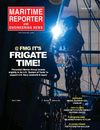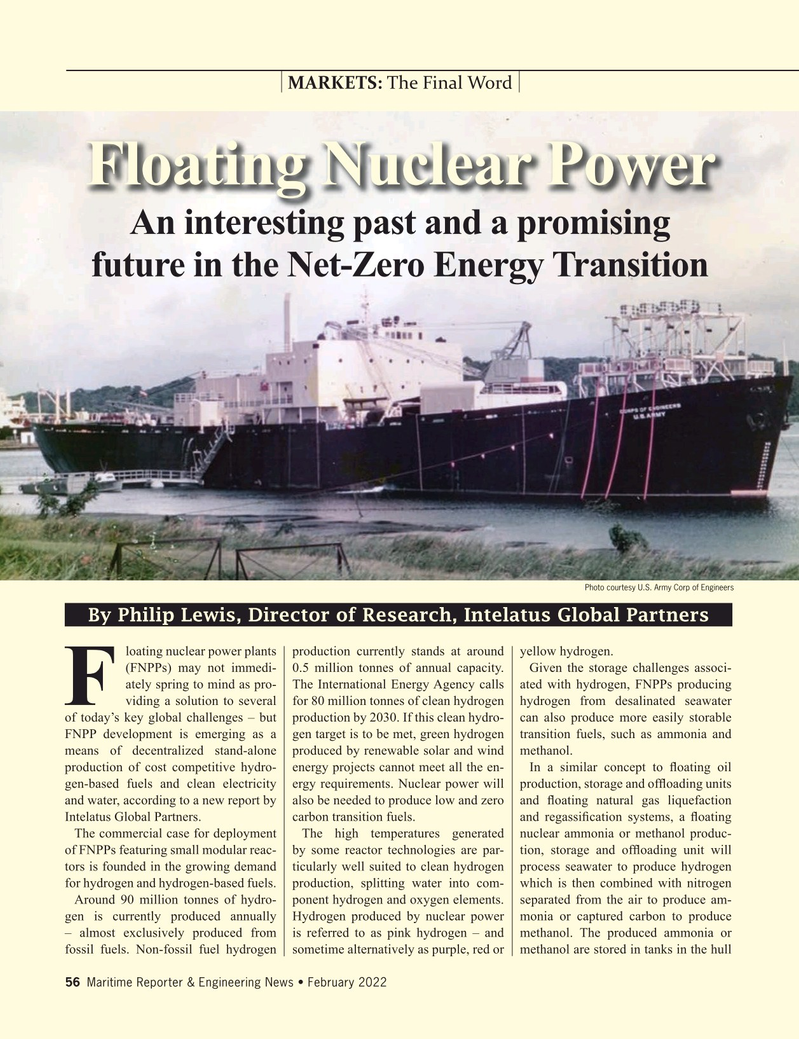
Page 56: of Maritime Reporter Magazine (February 2022)
Government Shipbuilding
Read this page in Pdf, Flash or Html5 edition of February 2022 Maritime Reporter Magazine
MARKETS: The Final Word
Floating Nuclear Power
An interesting past and a promising future in the Net-Zero Energy Transition
Photo courtesy U.S. Army Corp of Engineers
By Philip Lewis, Director of Research, Intelatus Global Partners loating nuclear power plants production currently stands at around yellow hydrogen. (FNPPs) may not immedi- 0.5 million tonnes of annual capacity. Given the storage challenges associ- ately spring to mind as pro- The International Energy Agency calls ated with hydrogen, FNPPs producing
F viding a solution to several for 80 million tonnes of clean hydrogen hydrogen from desalinated seawater of today’s key global challenges – but production by 2030. If this clean hydro- can also produce more easily storable
FNPP development is emerging as a gen target is to be met, green hydrogen transition fuels, such as ammonia and means of decentralized stand-alone produced by renewable solar and wind methanol. production of cost competitive hydro- energy projects cannot meet all the en- In a similar concept to ? oating oil gen-based fuels and clean electricity ergy requirements. Nuclear power will production, storage and of? oading units and water, according to a new report by also be needed to produce low and zero and ? oating natural gas liquefaction
Intelatus Global Partners. carbon transition fuels. and regassi? cation systems, a ? oating
The commercial case for deployment The high temperatures generated nuclear ammonia or methanol produc- of FNPPs featuring small modular reac- by some reactor technologies are par- tion, storage and of? oading unit will tors is founded in the growing demand ticularly well suited to clean hydrogen process seawater to produce hydrogen for hydrogen and hydrogen-based fuels. production, splitting water into com- which is then combined with nitrogen
Around 90 million tonnes of hydro- ponent hydrogen and oxygen elements. separated from the air to produce am- gen is currently produced annually Hydrogen produced by nuclear power monia or captured carbon to produce – almost exclusively produced from is referred to as pink hydrogen – and methanol. The produced ammonia or fossil fuels. Non-fossil fuel hydrogen sometime alternatively as purple, red or methanol are stored in tanks in the hull 56 Maritime Reporter & Engineering News • February 2022
MR #2 (50-59).indd 56 2/4/2022 9:06:51 AM

 55
55

 57
57
